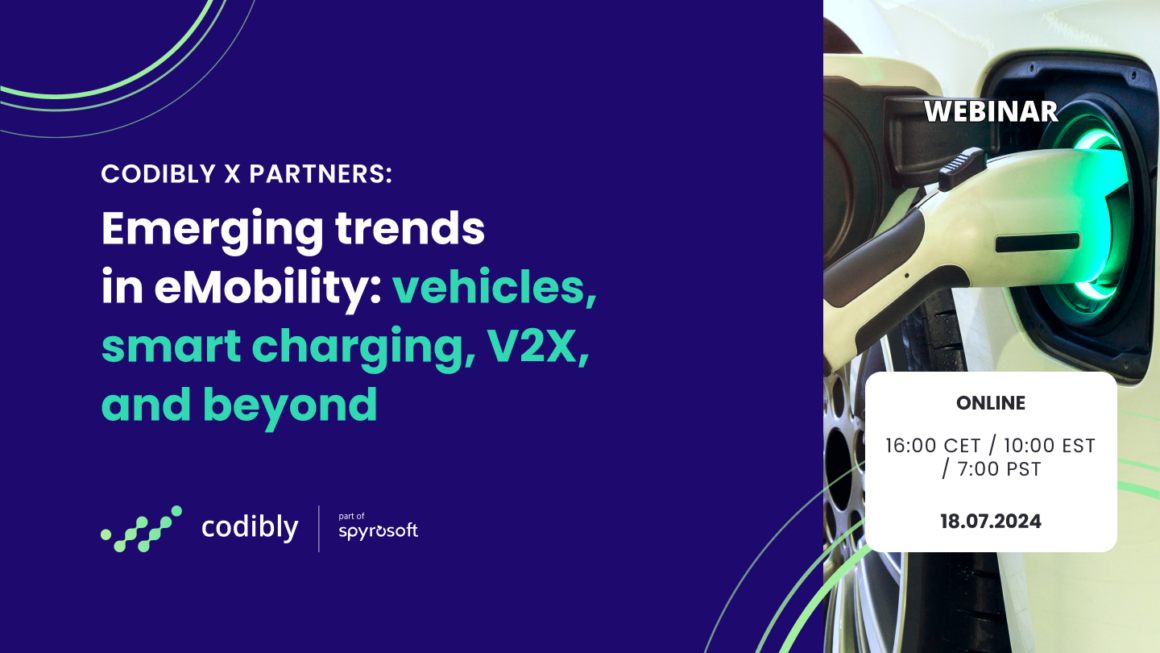Webinar: Emerging trends in e-Mobility: vehicles, smart charging, V2X, and beyond

On July 17th, 2024, Codibly hosted a webinar focused on the latest trends in e-mobility, featuring Spencer Borison, Bill Frykman, and Łukasz Kulczyński as key speakers. Bill Frykman, a veteran from Ford Motor Company, and Łukasz Kulczyński, Codibly’s e-mobility division lead, shared their insights into the EV market, charging infrastructure, and emerging technologies. The discussion highlighted the rapid evolution and challenges within the industry, emphasizing the importance of affordability, infrastructure, and positive communication. This shortened transcript captures the valuable insights and forward-looking perspectives shared during the event.
Spencer Borison: Hello, everyone, and welcome to today’s webinar. We’ll get started in just a moment as more attendees join.
I’m Spencer Borison, managing the US business for Codibly. Today, we’ll discuss e-mobility trends, focusing on vehicles, smart charging, and V2X. We have two esteemed panelists with us. They’ll introduce themselves, and then we’ll explore major trends in the US and European markets. We’ll also have time for closing remarks. Bill, would you like to start with your introduction?
Bill Frykman: Absolutely, thank you, Spencer. Hello from Detroit, Michigan. I’m Bill Frykman. I had a long career at Ford Motor Company, developing charging experiences for Ford’s electric and plug-in hybrid vehicles, including the Mustang Mach-E. I’ve recently been consulting in this space.
Łukasz Kulczyński: It’s a pleasure to be here. I’m Łukasz Kulczyński, currently based in Krakow. I’ve been in the software industry for 15 years, including seven years at Volkswagen Group. Now, at Codibly, I lead the e-mobility division, focusing on software and technology for this sector.
Spencer: For those unfamiliar with Codibly, we’ve been around for 13 years, working in Europe and North America in e-mobility and renewable energy. We specialize in consulting and developing software for OEMs, aggregators, and utilities. Now, let’s dive into the panel discussion.
Bill, could you share some key trends you’re observing in the EV industry?
Bill: Thank you, Spencer. It’s an exciting time in the electrification space. EVs are increasingly popular, with the Tesla Model E being the best-selling vehicle worldwide last year. Despite challenges like affordability and infrastructure, the market is growing. We’re still in the early days, and while there are obstacles, there are also numerous opportunities for innovation and expansion.
Spencer: Great, thank you. Łukasz, what are your thoughts on the trends and challenges in the EV space?
Łukasz:I fully agree with Bill; we’re just at the start of a significant journey in e-mobility. The market is rapidly evolving, with new technologies and expanding infrastructure. While there are challenges like high prices and concerns about charging infrastructure, there’s a lot of potential. Positive communication is crucial to counter negative perceptions and highlight the practical benefits of EVs, such as lower running costs and environmental advantages.
Spencer: Bill, can you provide insight into how established OEMs, especially those in Detroit, are adapting their strategies?
Bill: Certainly. Established OEMs are increasingly focusing on making EVs more affordable. For example, General Motors has launched the more budget-friendly Blazer EV, and Ford is shifting to new battery chemistries to reduce costs. There’s also a trend towards use-case-specific EVs, such as plug-in hybrids, which offer both electric and traditional fuel options, making them versatile for different driving needs. This adaptability is crucial as we move forward.
Łukasz: Affordability and infrastructure are indeed key concerns for potential EV buyers. There’s also a need for more positive messaging about EVs to counteract negative media stories. Despite concerns like residual value, the market is moving towards more competitive pricing, particularly with pressure from Chinese manufacturers. This competition is likely to drive prices down and make EVs more accessible to a broader audience.
Spencer: Let’s delve into the infrastructure and charging ecosystem. Łukasz, could you share your thoughts on the developments in this area?
Łukasz: In Europe, the number of public chargers is steadily increasing, although the market dynamics differ from those in the US. Public charging isn’t yet the most profitable business, but it’s essential for EV adoption. Integration with home energy management systems and ensuring interoperability between different chargers and systems are crucial. There’s a growing emphasis on dynamic load management, especially for fleet operations, to optimize charging and manage grid demand efficiently.
Bill: In the US, we’re seeing more consolidation among charge point operators, which is helping to standardize the infrastructure. The number of chargers is increasing, and they’re becoming more robust. The evolution parallels the cell phone industry, where standardization and infrastructure improvements significantly enhanced user experiences. Additionally, we’re seeing greater integration with renewable energy sources, like solar power, which complements the growth of EVs and offers new possibilities for energy management, such as using EVs as energy storage devices.
Spencer: We’re nearing the end of our session. Do you have any final thoughts or trends you’re particularly interested in?
Bill: Change is happening rapidly in the EV sector, and we’re just beginning to see the full potential of this ecosystem. The next five years will bring significant advancements, especially as more aspects of the industry become integrated.
Łukasz: I agree. It’s important to stay positive and look forward to the exciting technologies on the horizon. The growth in e-mobility and infrastructure is just beginning, and there’s much more to come.
Spencer: Thank you both for your insights and for sharing your expertise with us today.
contact us
Need expert guidance on your next energy project?
Reach out to us and discover how Codibly can offer tailored solutions to drive your business.